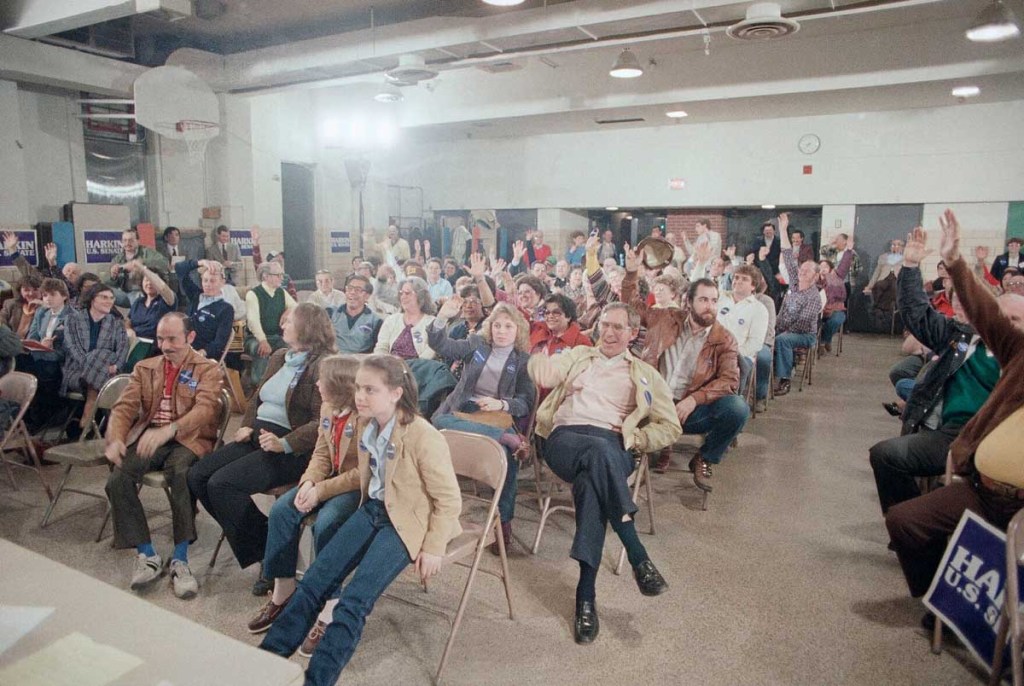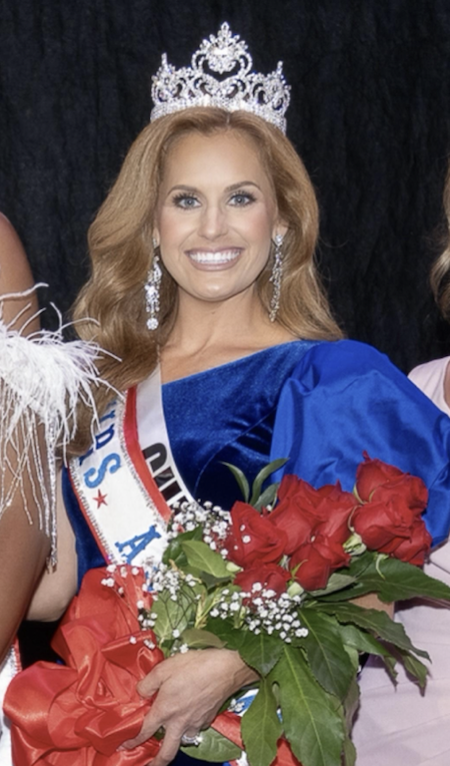The Iowa Caucuses: First in the nation since 1972
Published 11:15 pm Tuesday, January 9, 2024

- Hands go up to vote for former Vice President Walter Mondale on Monday night, Feb. 20, 1984 at a Democratic Precinct Caucus at St. Anthony’s Church School in Des Moines.
OSKALOOSA — The Iowa Caucuses, the state’s tradition-laden, grass-roots approach to picking presidential candidates, arrives Monday. But for Democrats, the tradition is taking on a different look.
The Republican Caucus is set for Jan. 15, with delegates from all 99 Iowa counties prepared to select their candidate. Former President Donald Trump has maintained a dominating lead in pre-caucus polling. FiveThirtyEight, a website created by Nate Silver that analyzes opinion polling, shows Trump has about 51.3% of support among likely Iowa Republican caucus attendees. DeSantis and Haley are second and third in consensus polling with 17.2% and 15.8%, respectively.
The Democrats will also caucus Jan. 15, but that meeting will be to determine party platforms and not their preferred presidential nominee. Instead, national decisions have forced Iowa Democrats to use a mail-in presidential preference process from Jan. 12 through March 5 to determine how Iowa’s delegates will vote at the Democratic National Convention in Chicago.
Even with Democratic Party changes, Republicans have held true to tradition as their efforts to deny President Joe Biden’s re-election bid has kept the focus on Iowa’s oft-debated process.
As a format, the Iowa Caucuses date back to the 19th Century when they began as an informal process soon after the state’s founding in 1846. Over time they became more and more structured, but it wasn’t until 1972 when they became binding at the national level.
The Iowa Caucuses: A history since 1968
Kedron Bardwell, a professor of political science at Simpson College in Indianola, defines the caucuses as “a bit of a unique institution.” Rather than a state-run political primary, the Iowa Caucuses are a party-run system of meetings where party and platform business is discussed, and attendees indicate their preference for the presidential nominee. Unlike the usual primary election setup where polls are open for all-day voting, caucus meetings are held at a fixed time and must be attended to participate.
The Iowa Caucuses as they exist today were born out of the chaotic Democratic Convention of 1968. President Lyndon B. Johnson was in the White House, but with the Vietnam War raging and political upheaval the new normal, he decided not to run for another term. His choice to step down set the stage for a political fiasco that would forever change the presidential nomination process.
“You had a lot of anti-war sentiment in the Democratic Party, especially among the base, but the process nationally that we had for selecting the nominee was really kind of a world of backroom deals and smoke-filled rooms, kind of that traditional vision of American politics,” Bardwell said.
At the national convention, in the wake of Johnson’s decision not to run, the Democratic delegates began backing his vice president, Hubert Humphrey. It proved an unpopular decision with the party’s base due to Humphrey’s support of the war effort in Vietnam.
“The establishment mayor of Chicago, [Richard] Daley, took a lot of steps that angered the protesters and tried to silence them,” Bardwell explained. “And so it erupted into basically chaos, not just outside the convention hall, but in on the floor, between the anti-war faction and the establishment in the Democratic Party.”
As a result, the national Democratic Party decided that each state needed to establish a better system for representing the opinions and sentiments of its voters, so the delegates who would go on to vote at the national convention would be more representative of the voters at home.
Most states chose the simple route of holding a self-explanatory, binding primary election; Iowa chose a different path. Democrats held their first Iowa Caucus in 1972, and Republicans held their first in 1976.
The Iowa Caucuses: First in the nation, but for how long?
Iowa’s path to becoming the nation’s first contest for presidential hopefuls was not necessarily intentional. But after the contest landed in January as the nation’s first, state officials for both parties have made significant efforts to maintain the status quo.
In 1972, Democrats were concerned about the time it would take to copy all of the paperwork from caucus meetings onto a mimeograph machine and then distribute the copies between the local caucuses, to the county conventions, and then on to district and state conventions.
“They knew that they needed a certain amount of time to get all of the documents to all of the players, and all the attendees, and all of the counties, and then all the district conventions, and so they wanted to back up and have essentially about four weeks … between each of the stages of the caucus-to-convention process,” Bardwell said.
Counting backwards from the state convention, the start of the process landed in January and has remained a midwinter affair in Iowa ever since.
Iowa’s first-in-the-nation status has had a huge impact on the state, both politically and economically, shining a spotlight on the state and generating millions of dollars in political-related spending. Andrew Green, a professor of political science at Central College in Pella, says that the change was almost immediate. The impact from the 1972 caucus carried forward into the 1976 election.
“What they realized, in the aftermath [of 1972], because Iowa ended up being the first caucus in the country that year, was that the candidates really paid attention to the state, and as a result of that the media also paid attention to the state as well,” Green said. “So in 1976, the Iowa Republican Party also decided to move their caucuses early on the same evening as the Democrats … That was the cycle where a relatively unknown governor from Georgia, Jimmy Carter, came to the state, unexpectedly came in second in the Iowa Caucuses, and then vaulted his way to the nomination, and ultimately to the presidency.”
Carter took home 27.6% of the vote in the 1976 Democratic caucuses after heavy campaigning in the leadup, making him the winner among the five named candidates. As another 37.2% of the vote was uncommitted, the caucuses gave Carter the momentum he needed to eventually win the nomination.
“That really was the genesis for the emphasis for the Iowa Democratic Party and the Iowa Republican Party to keep their caucuses first, and they’ve worked very, very hard over the last 40, 45 years to do so,” Green added.
To court Iowa’s voters, candidates often start building political networks in Iowa years in advance of the nomination cycle. Political spending skyrockets as campaign teams and the media descend on the Midwest, first in smaller bites for an “invisible primary” in the years leading up to the nomination, then in mass quantities for the real deal.
“We’re talking about campaign offices being leased. We’re talking about convention centers being booked, meeting spaces being booked, you name it. Which all brings a lot of money into the state,” Green said.
In the aftermath of the 2020 presidential election, the Democratic National Committee’s Rules and Bylaws Committee voted to designate South Carolina as the leadoff presidential nominating state. Green said key reasons include voter-accessibility given the time commitment of the caucuses and Iowa’s demographics.
“Iowa, demographically, is much more white than a lot of other areas of the country, other states in the nation,” Green said. “So there were real questions about whether starting in Iowa made sense for a party that wasn’t necessarily demographically represented in the state.”
Iowa law requires that the parties hold caucuses prior to the first Monday in February. Republicans hold a near super-majority in the two chambers of the Iowa Legislature, and have signaled no appetite to change the law to support Democrats’ desires to move the caucuses.
The Iowa Caucuses: The political climate today
The caucuses have generally been more accurate on the Democratic side, but largely have not served as a good fortune-teller in presidential races. Both Carter and Barack Obama won in Iowa before ascending to the presidency, but on the Republican side, winning in Iowa hasn’t traditionally been enough. George W. Bush, in 2000, was the last Republican to win Iowa and wind up the Republican nominee.
“Going from Mike Huckabee to Ted Cruz, Rick Santorum … the last several winners of the Iowa caucus have gone nowhere after Iowa,” Bardwell said.
The acrimony that has plagued American politics in recent years serves to both complicate the situation, and intensify it. For one thing, it’s a good way to ensure the voters come out in force.
“Funny thing is, acrimony sometimes drives up turnout,” Bardwell said. “That’s actually what we found in the last election, is that we had the highest turnout we’ve had in decades, and partly because it was such an acrimonious race between [Donald] Trump and [Joe] Biden.”
Still, in spite of everything, on Jan. 15 the world will be watching Iowa, and democracy’s greatest race will once again hit “go.”
“The real question for me,” Green said, “in looking forward to New Hampshire and beyond, is whether one of the Trump alternative candidates overperforms and builds some momentum going into New Hampshire. If that happens, I think that that could change the dynamics moving forward. But if the Trump alternative candidates underperform, or perform to expectation, I think at that point, it’s pretty safe to predict that Trump will win the nomination again.”





